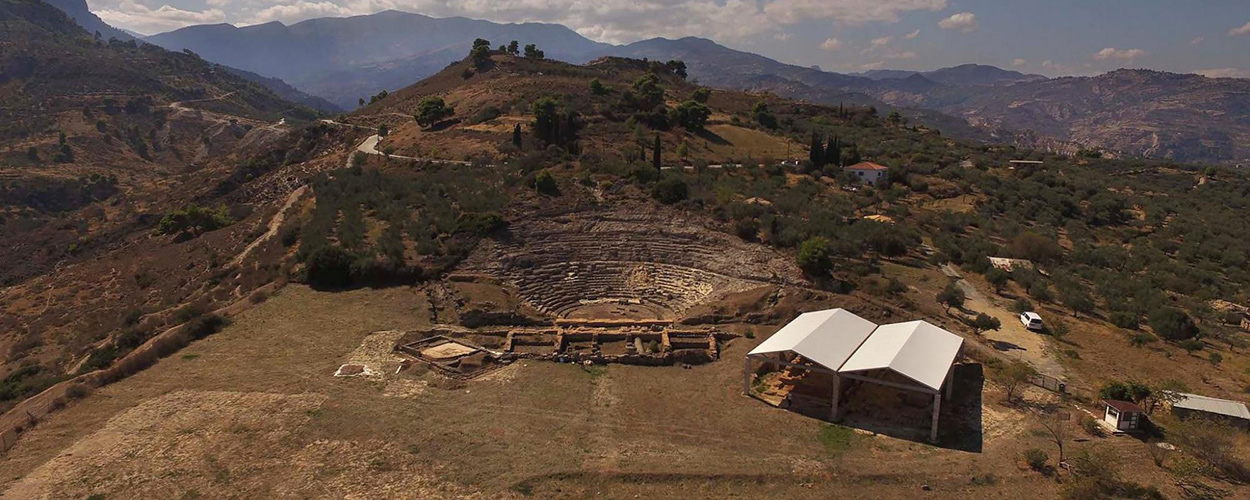Aigeira
Aigeira, located high above the Gulf of Corinth, is one of the most important ancient sites in the region of Achaia in the north-west Peloponnese. Otto Walter, accompanied by the writings of Pausanias, undertook the first excavations here in 1916 and 1925. Since 1972, the OeAI has continuously carried out the systematic investigation of the ancient city. The history of Aigeira can now be followed, with interruptions, from the mid-Neolithic era (6th millennium B.C.) until the Mediaeval period.

Late Bronze Age Settlement and Early Sanctuary on the Acropolis
The settlement which was founded at the end of the Mycenaean palace period around 1200 B.C., and which existed in a number of phases over a time period of more than 150 years, is particularly significant. After a serious catastrophe caused by fire, presumably in the middle of the 12th century B.C., a successor settlement was erected immediately on top of the ruins, and was surrounded by a massive fortification wall. This defensive wall, which suggests that the inhabitants of Aigeira now needed increasing protection, is an exceptional phenomenon for the late phase of the Bronze Age, and one which until now is without parallel in the Peloponnese.
As at numerous other settlement sites, Aigeira was also abandoned in the course of the 11th century B.C. Renewed usage of the site can only be recognised at the earliest in the mid-8th century B.C., when a sanctuary on the acropolis was set up. Amongst the many finds from the sanctuary, an elaborately fashioned Corinthian roof belonging to a late Archaic temple is particularly noteworthy.
The latest usage of the acropolis extends into the 12th century A.D., attested by coins and pottery finds. The renewed fortification with an enclosure wall constructed of ancient spolia probably also dates to this period.


Hellenistic Guesthouse and Coin Hoard Trove
On a terrace directly to the north below the acropolis, a building complex with substantial mosaics, dating roughly to the mid-4th century B.C., has been discovered. It probably served as a guest house for official delegations. In the course of its use up until the 1st century B.C. many conversions and extensions took place, resulting in the complex occupying a surface area of almost 1,000 m².
A coin hoard consisting of nearly 600 silver coins is a remarkable find from the guest house. This hoard was probably hidden under the flooring of the guest house in the course of the raid by the Aitolians in 219 B.C. to protect it from the invaders.

A City of the Achaian League
Without doubt, the greatest heyday of Aigeira occurred during the Hellenistic period. The small city, until that time relatively modest in size, was increased by a factor of 14 during a building programme which was probably funded by financial support from the Achaian League.
The founding of numerous new public structures, as well as the construction of an aqueduct and an approximately 3,000 m. long fortification wall around the city date to this period. Many buildings erected after the mid-3rd century B.C. in the immediate vicinity of the theatre – amongst others a peripteral temple and at least five small buildings designated as naiskoi – constitute one of the most interesting building ensembles of the Hellenistic period in the Peloponnese. The theatre region remained one of the most important public centres of the ancient city until the mid-imperial Roman period. Its function changed only in the 4th and 5th centuries A.D., due to the abandonment or transformation of previously public and religious structures into workshops.
While the public buildings of Aigeira are well-studied, in particular those in the theatre region, very little is known about daily life in the almost 50 ha Hellenistic and Roman city. A cooperative study with the Greek Ministry of Culture and Sports aims to investigate this issue.
Head of the excavation
Duration
since 1972
Sponsoring
OeAI